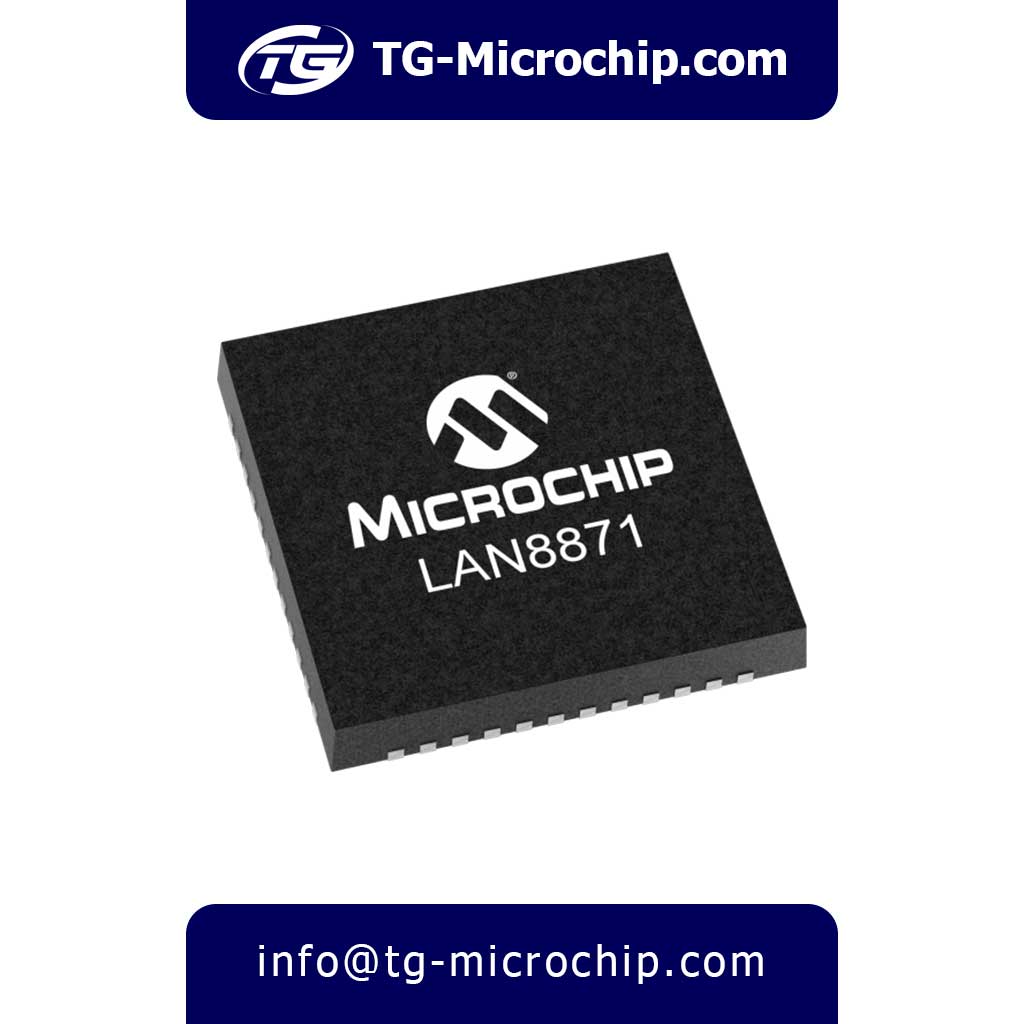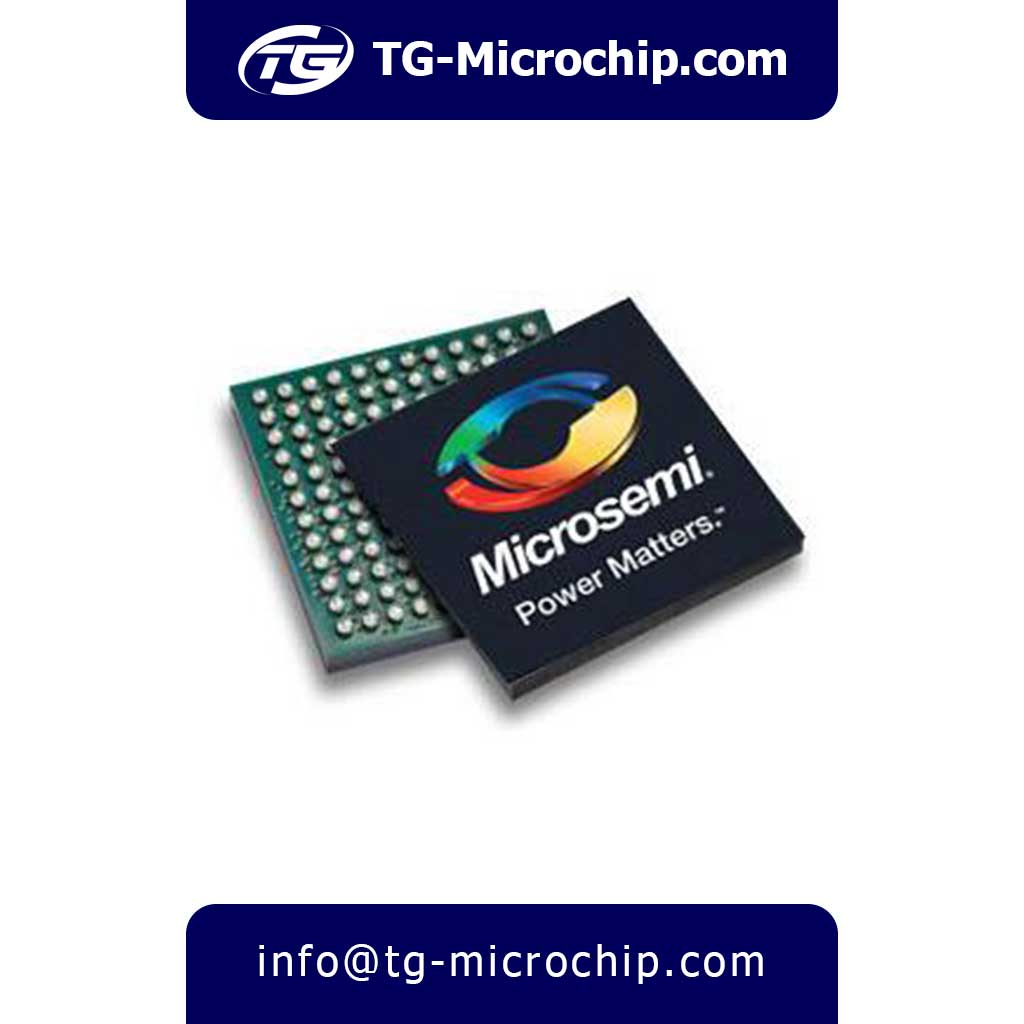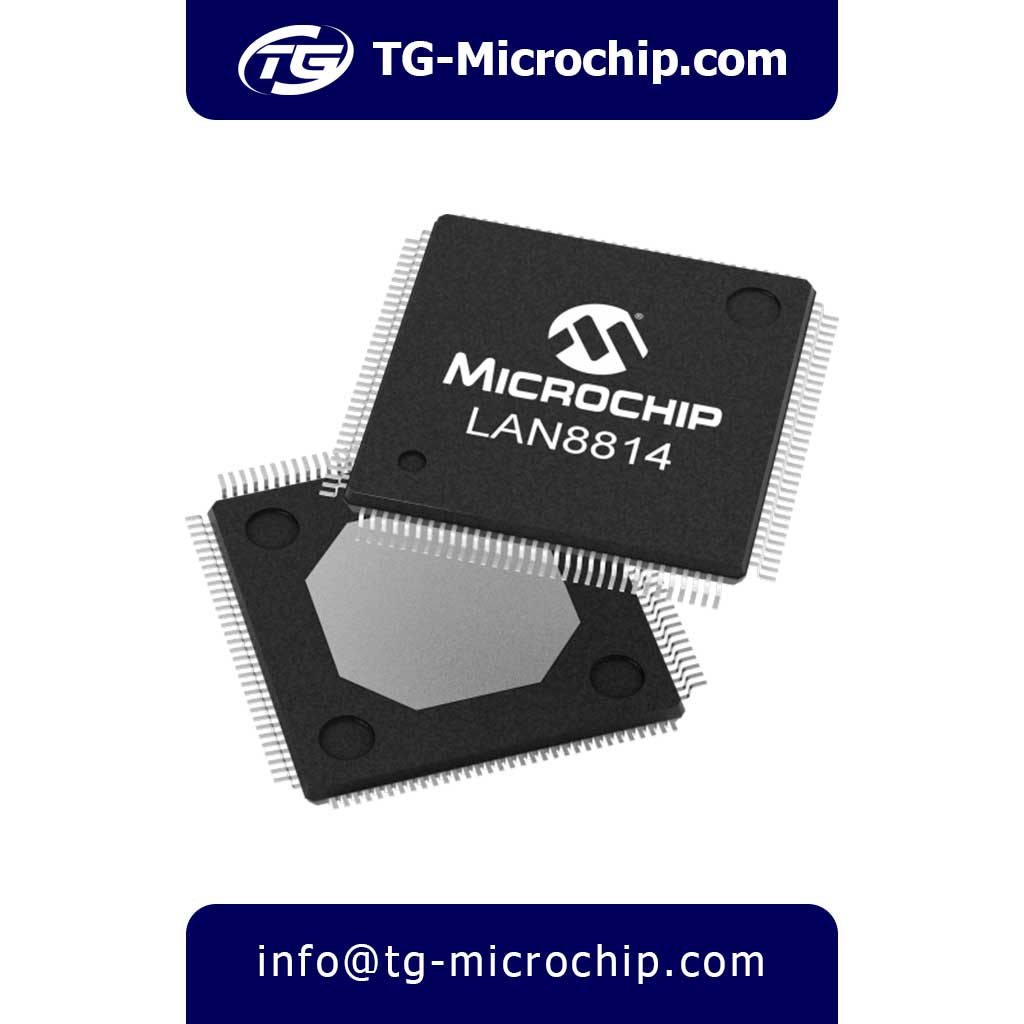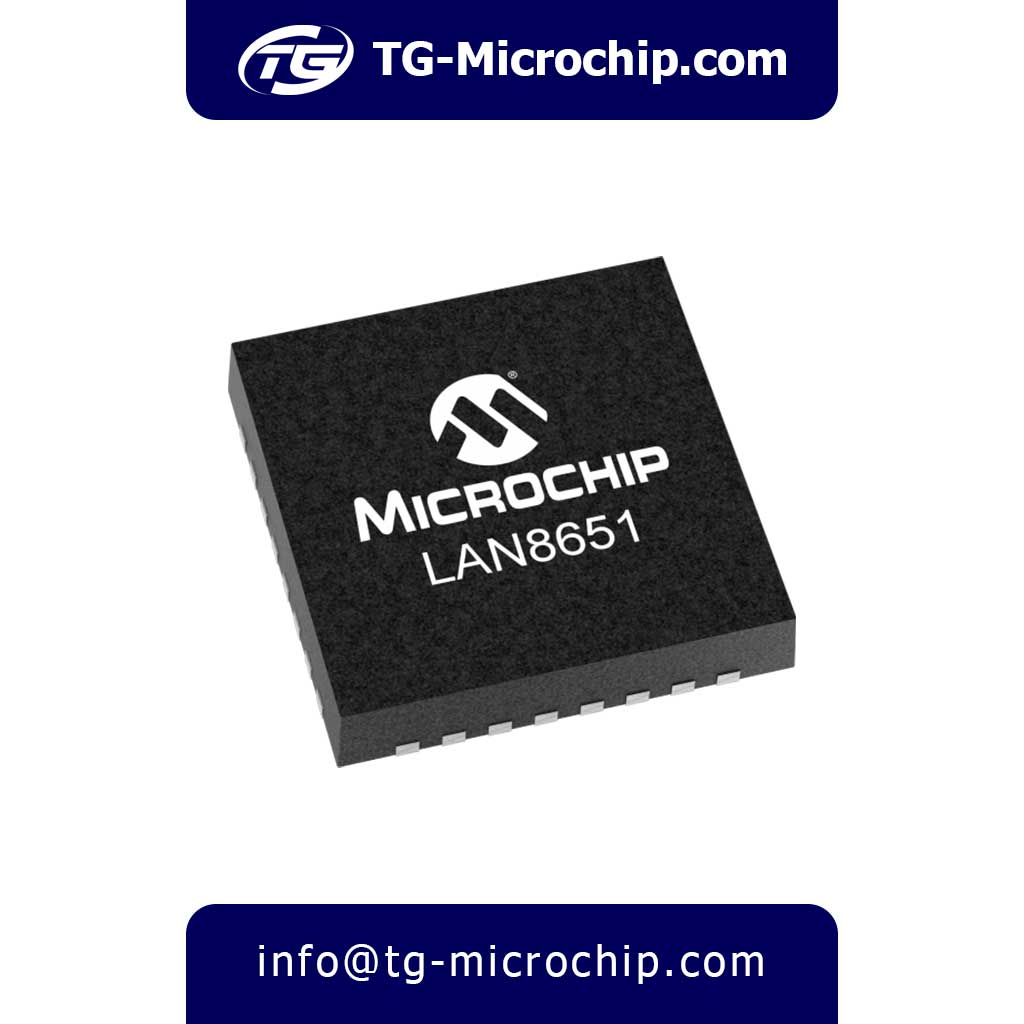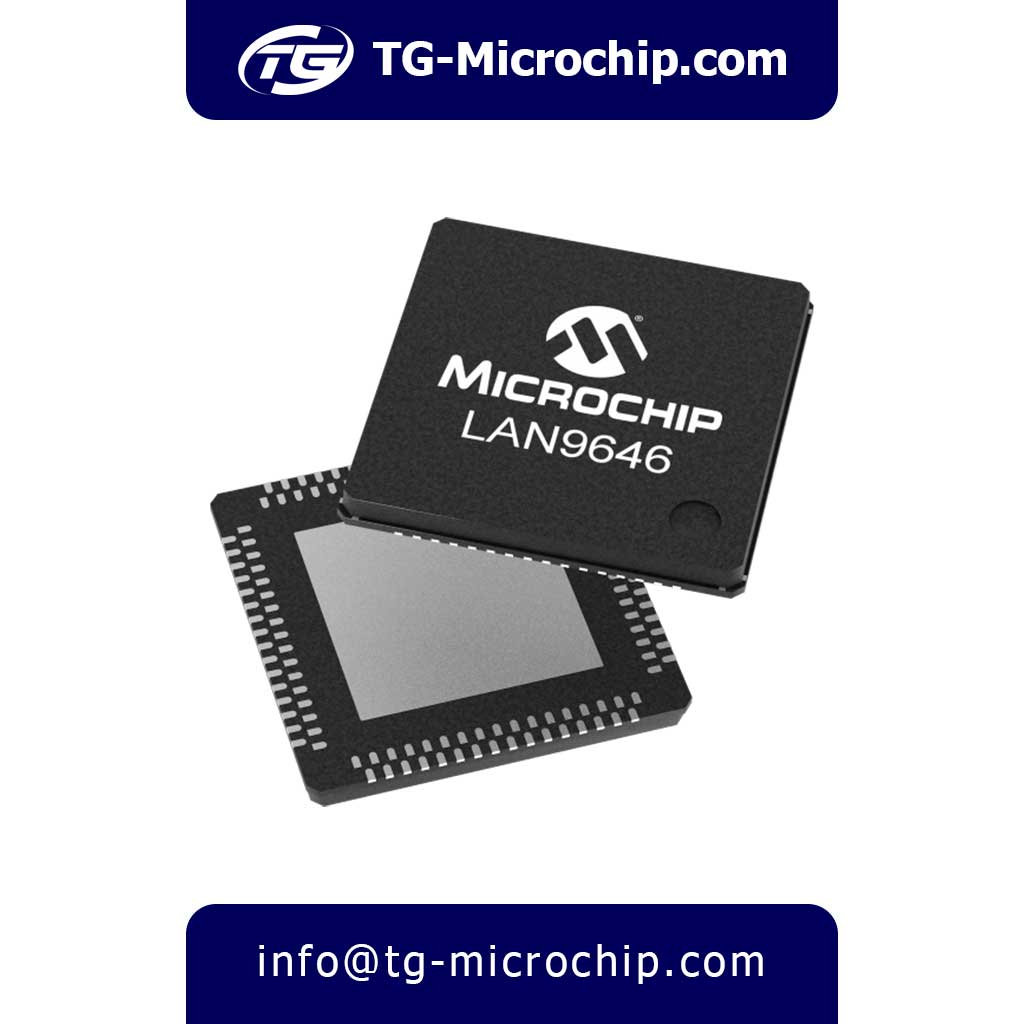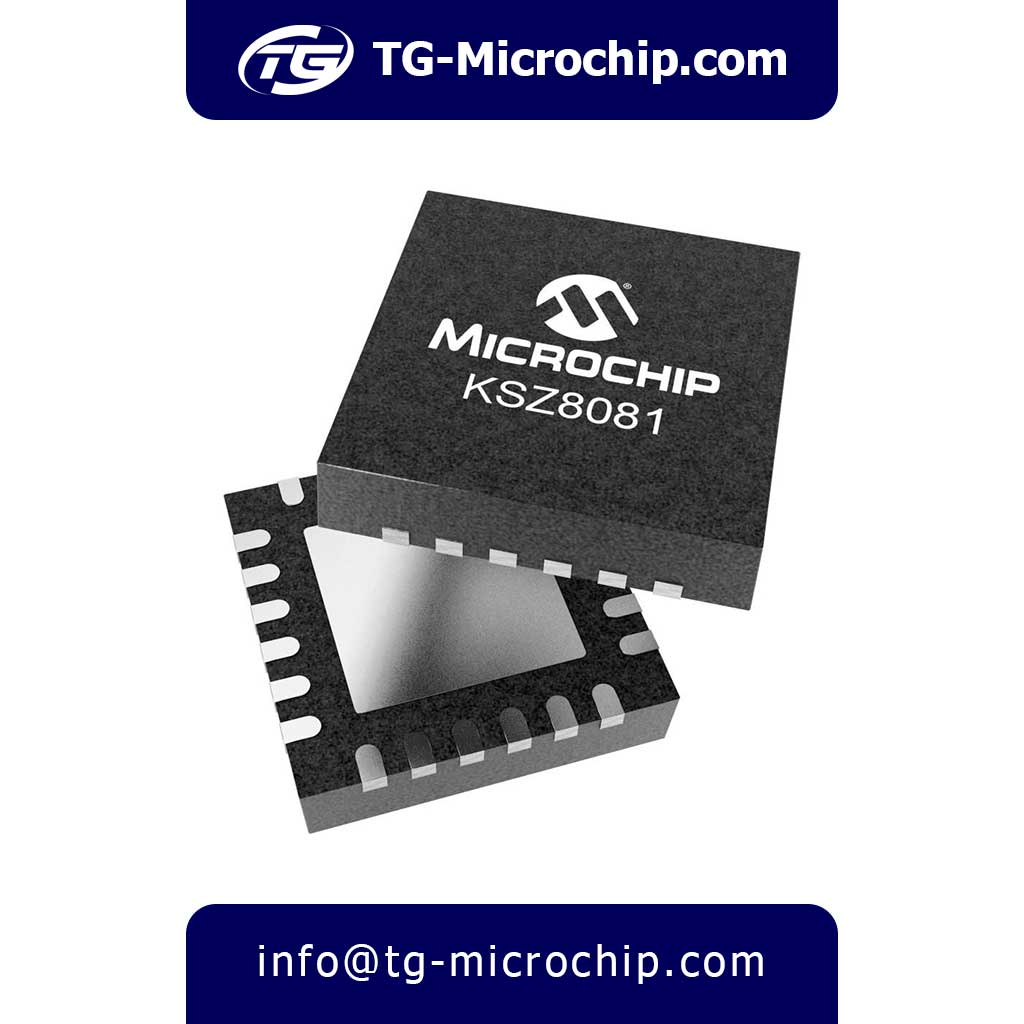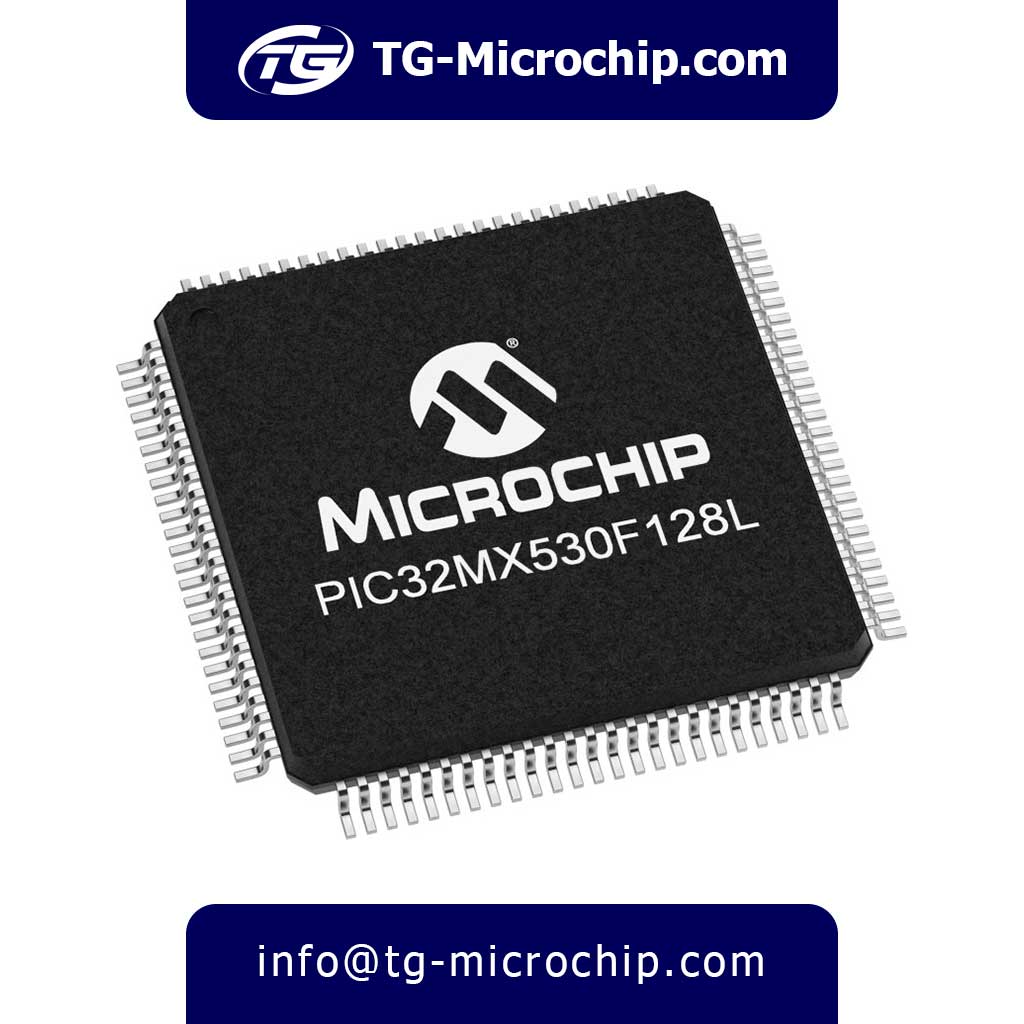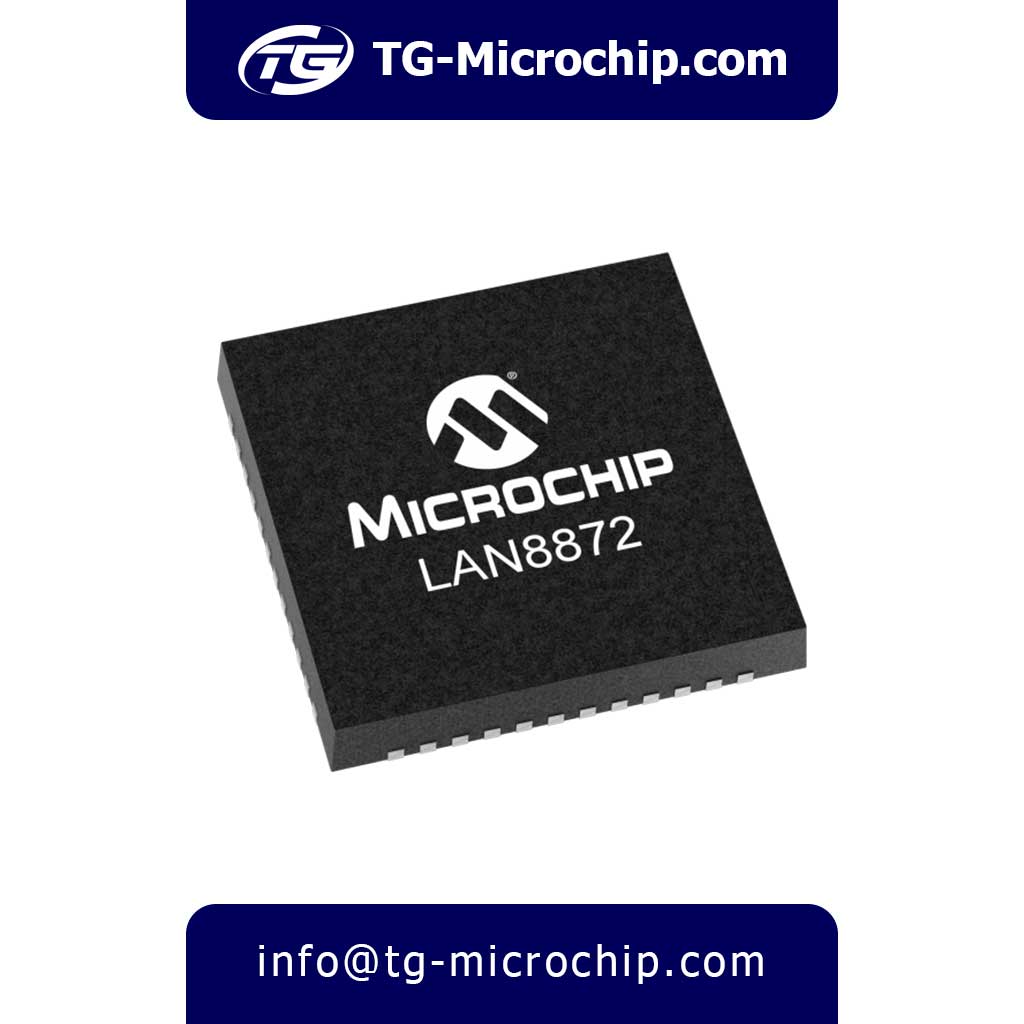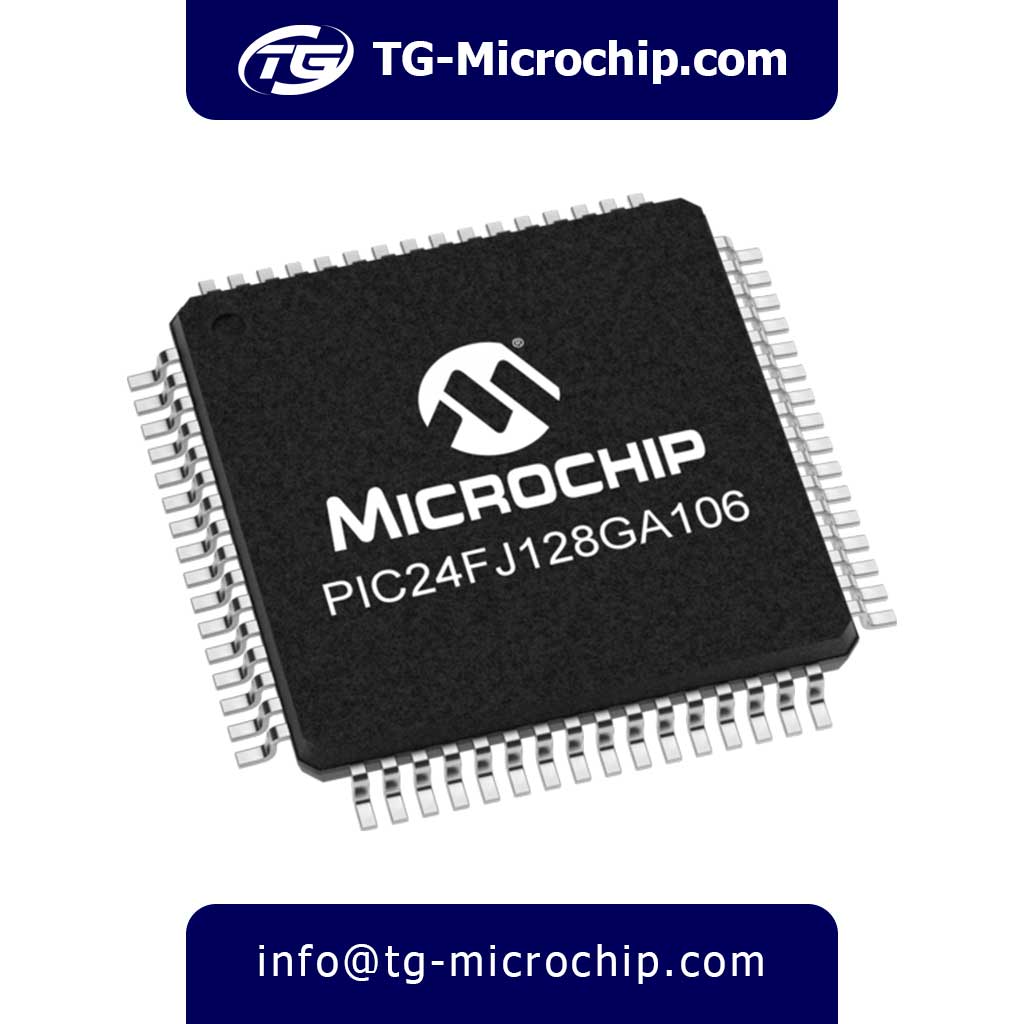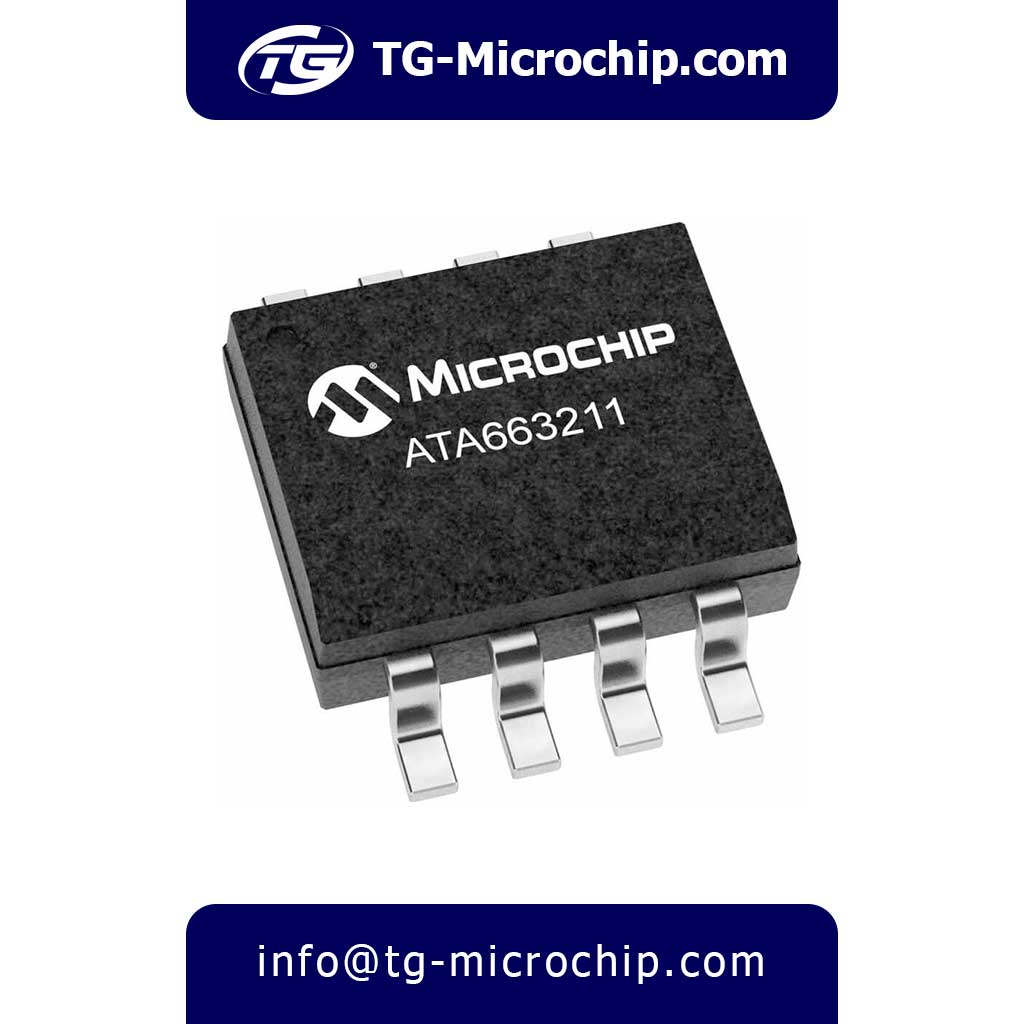For order or price inquiry of LAN8871-I/PUA Microchip Technology Please click on Buy Order button and fill the RFQ form we will check out inventory and offer you our best price.
Quick Access
About
The LAN8871-I/PUA is a high-performance Ethernet transceiver from Microchip Technology, designed to support Gigabit Ethernet (1000Base-T1) over a single twisted-pair cable. It integrates both MAC (Media Access Control) and PHY (Physical Layer) functionalities, making it a compact solution for embedded networking applications. Compliant with the IEEE 802.3bp standard, it enables full-duplex communication at speeds of 10Mbps, 100Mbps, and 1Gbps, catering to industrial and automotive networking needs.
This transceiver features a Reduced Gigabit Media Independent Interface (RGMII), allowing seamless integration with host processors and switches. Its 3.3V I/O voltage and 1.2V core voltage ensure efficient power management, while the low-latency mode enhances real-time data transmission. Additionally, the LAN8871-I/PUA supports Wake-on-LAN (WoL), enabling energy-efficient operation in power-sensitive applications.
Packaged in a 48-pin VQFN (7×7 mm) with an exposed thermal pad, the device is optimized for surface-mount (SMD) assembly and features wettable flanks for improved solder joint inspection. Its industrial-grade operating temperature range (-40°C to +85°C) ensures reliability in harsh environments, including automotive and industrial automation systems. The RoHS-compliant design further aligns with global environmental standards.
Key applications include automotive Ethernet (1000Base-T1), industrial IoT gateways, and embedded networking systems where high-speed, low-latency communication is critical. The integrated ESD protection (up to 8kV HBM) enhances robustness against electrostatic discharge, making it suitable for mission-critical deployments.
In summary, the LAN8871-I/PUA combines high-speed Ethernet connectivity, power efficiency, and ruggedness in a single chip, addressing the growing demand for reliable wired communication in next-generation automotive and industrial systems. Its compliance with industry standards and advanced feature set make it a versatile choice for designers seeking a compact yet powerful Ethernet solution.
Key Features
Core Architecture
- Single-chip integrated 10/100/1000 Mbps Ethernet MAC+PHY solution
- Fully compliant with IEEE 802.3bp (1000BASE-T1) standard
- Supports IEEE 802.3 Clause 40 (1000BASE-T1 PCS)
- Implements IEEE 802.3 Clause 98 (1000BASE-T1 PMA)
- Integrated SERDES for single twisted pair operation
- Full-duplex operation only (no half-duplex mode)
Physical Layer (PHY) Features
- Supports 1000BASE-T1, 100BASE-T1 and 10BASE-T1S
- Adaptive equalization with 24dB compensation capability
- Baseline wander correction (BWC) circuitry
- Programmable transmitter output amplitude (±10% adjustment)
- Programmable transmitter pre-emphasis
- Programmable receiver equalization
- Auto-MDIX (automatic media-dependent interface crossover)
- Cable diagnostics using LinkMD® technology
- Built-in self-test (BIST) capabilities
- Jitter performance compliant with IEEE 802.3bp specifications
- Support for up to 15m unshielded cable (1000BASE-T1)
MAC Layer Features
- Full IEEE 802.3 compliant Media Access Controller
- Supports jumbo frames up to 9KB
- VLAN tagging support (IEEE 802.1Q)
- Flow control (IEEE 802.3x)
- CRC generation and checking
- Frame padding/truncation
- Programmable inter-packet gap (IPG)
- Programmable frame length checking
- MAC address filtering
- Multicast address filtering
- Broadcast frame filtering
Interface Features
- RGMII v2.0 compliant interface
- MDIO interface for PHY management
- Supports Clause 22 and Clause 45 MDIO
- Programmable LED outputs (link, activity, speed)
- 25MHz reference clock input
- 125MHz clock output
Power Management
- Multiple power modes:
- Normal operation mode
- Power-down mode
- Energy Detect mode
- Wake-on-LAN mode
- Per-block power management
- 1.2V core voltage supply
- 3.3V I/O voltage supply
- Separate power supply for analog circuits
- Power supply monitoring
Package and Physical Characteristics
- 48-pin VQFN package (7mm × 7mm body)
- 0.5mm pitch
- Exposed thermal pad for enhanced heat dissipation
- Wettable flank package design
- Lead-free and RoHS compliant
- MSL3 (Moisture Sensitivity Level 3) rated
Environmental Specifications
- Operating temperature range: -40°C to +85°C
- Storage temperature range: -65°C to +150°C
- ESD protection:
- 8kV HBM (Human Body Model)
- 1kV CDM (Charged Device Model)
- Industrial-grade EMI/EMC performance
Diagnostic and Control Features
- Comprehensive status monitoring:
- Link status
- Speed indication
- Duplex status
- Energy Detect status
- Multiple loopback modes:
- PHY loopback
- MAC loopback
- External loopback
- Extensive PHY register set (over 100 registers)
- Programmable interrupt outputs
- Error counters for diagnostics
Automotive Specific Features
- AEC-Q100 Grade 2 qualified
- Supports automotive environmental requirements
- Enhanced EMC performance for automotive applications
- Specialized automotive wake-up features
Timing Characteristics
- RGMII timing compliant with RGMII v2.0 specification
- MDIO timing compliant with IEEE 802.3
- Clock timing tolerance within ±50ppm
Manufacturing Features
- Industrial standard manufacturing flow
- Production tested at temperature extremes
- Full characterization data available
- Quality and reliability monitoring
Software Support
- Comprehensive register documentation
- Reference software drivers available
- Evaluation board support package
- Linux driver support
Security Features
- MAC address protection
- Register access protection
- Configuration lock capability
Applications
1. Automotive Ethernet Networks
- In-Vehicle Infotainment (IVI) Systems: Enables high-speed data transfer for multimedia content, navigation, and connectivity features in modern vehicles. The 1000BASE-T1 support ensures low-latency streaming and firmware updates.
- Advanced Driver Assistance Systems (ADAS): Supports real-time data transmission for cameras, radar, and LiDAR sensors, critical for autonomous driving and collision avoidance.
- Vehicle Telematics: Facilitates reliable communication for GPS, vehicle diagnostics, and over-the-air (OTA) updates, meeting automotive-grade temperature and EMI requirements.
- Ethernet Backbone for Zonal Architectures: Acts as a node in centralized vehicle networks, connecting ECUs (Electronic Control Units) with reduced wiring complexity.
2. Industrial Automation
- Factory Automation: Integrates with PLCs (Programmable Logic Controllers) and HMIs (Human-Machine Interfaces) for real-time control and monitoring. The industrial temperature range (-40°C to +85°C) ensures reliability in harsh environments.
- Industrial IoT (IIoT) Gateways: Connects sensors and actuators to cloud platforms via Ethernet, leveraging RGMII for seamless processor integration.
- Motion Control Systems: Provides deterministic communication for robotics and CNC machines, with support for IEEE 1588 precision timing protocols.
3. Smart Grid and Energy Management
- Smart Meters: Enables secure and high-speed data collection for energy usage monitoring, with robust ESD protection for field deployments.
- Grid Substation Communication: Supports fault-tolerant networking in power distribution systems, compliant with industrial EMI standards.
4. Building Automation
- HVAC Control Systems: Connects thermostats and actuators for energy-efficient climate control, utilizing low-power modes for sustainability.
- Security and Surveillance: Integrates with IP cameras and access control systems, offering stable Gigabit Ethernet performance for high-resolution video streams.
5. Medical Devices
- Patient Monitoring Systems: Ensures reliable data transmission for vital signs and diagnostic equipment, with low-latency operation for real-time feedback.
- Medical Imaging: Supports high-bandwidth transfer of MRI/CT scan data, leveraging jumbo frame support for efficient large-file handling.
6. Aerospace and Defense
- Avionics Communication: Used in flight control systems and in-flight entertainment, meeting stringent reliability and temperature requirements.
- Military Vehicle Networks: Provides secure, high-speed connectivity for tactical communication systems, with AEC-Q100-like robustness.
7. Consumer Electronics
- Gigabit Smart Home Hubs: Connects IoT devices (e.g., smart lights, appliances) with centralized controllers, using 1000BASE-T1 for future-proofing.
- Gaming Consoles: Supports low-latency wired networking for multiplayer gaming and cloud streaming.
8. Transportation and Logistics
- Fleet Management Systems: Enables real-time tracking and diagnostics for commercial vehicles, with automotive-grade durability.
- Railway Communication: Used in train control and passenger Wi-Fi systems, resistant to vibration and extreme temperatures.
Key Advantages for These Applications
- Single Twisted-Pair Efficiency: Reduces cabling weight and cost in automotive/industrial settings.
- Time-Sensitive Networking (TSN) Readiness: Ensures deterministic performance for critical real-time applications.
- Compact Design: The 48-pin VQFN package (7×7 mm) fits space-constrained devices.
Advantages
System-Level Advantages
- Simplified Design Integration – The integrated MAC+PHY architecture eliminates the need for external components, reducing overall system complexity and BOM costs
- Space Optimization – Compact 48-pin VQFN package enables high-density PCB layouts for space-constrained applications
- Reduced Development Time – Comprehensive software support and reference designs accelerate time-to-market for new products
- Lower Power Consumption – Advanced power management features minimize energy usage compared to discrete MAC+PHY solutions
- Improved Signal Integrity – Built-in adaptive equalization and baseline wander correction ensure reliable data transmission over challenging media
Performance Advantages
- Consistent High-Speed Performance – Maintains stable 1Gbps operation across the full industrial temperature range
- Enhanced Reliability – Robust ESD protection (8kV HBM) safeguards against electrostatic discharge events
- Superior EMI Characteristics – Programmable slew rate control and optimized package design reduce electromagnetic interference
- Low Latency Operation – Optimized data path minimizes transmission delays for time-sensitive applications
- Long-Distance Capability – Supports up to 15m cable lengths in 1000BASE-T1 mode without signal degradation
Industrial & Automotive Advantages
- Extended Temperature Operation – -40°C to +85°C range ensures reliable performance in harsh environments
- Automotive-Grade Robustness – AEC-Q100 qualification guarantees operation in demanding automotive applications
- Vibration Resistance – Robust package design maintains electrical connections in high-vibration environments
- Moisture Protection – MSL3 rating provides enhanced protection against humidity during manufacturing and operation
- Long-Term Availability – Microchip’s product longevity program ensures supply stability for industrial applications
Manufacturing Advantages
- Improved Production Yield – Wettable flank package design enables reliable automated optical inspection (AOI)
- Simplified Assembly Process – Standard surface-mount technology (SMT) compatibility reduces manufacturing complexity
- Thermal Management – Exposed thermal pad enhances heat dissipation without requiring additional heatsinks
- Supply Chain Flexibility – RoHS compliance ensures global acceptance and simplified logistics
- Quality Assurance – Production testing at temperature extremes guarantees out-of-box reliability
Maintenance & Operational Advantages
- Enhanced Diagnostics – Built-in LinkMD® cable diagnostics simplify troubleshooting and maintenance
- Remote Monitoring – Comprehensive status registers enable detailed system health monitoring
- Flexible Configuration – Programmable features allow field optimization without hardware changes
- Future-Proof Design – Support for emerging standards ensures long-term compatibility
- Reduced Field Failures – Robust design and extensive protection features minimize operational downtime
Cost Advantages
- Lower Total Cost of Ownership – Integrated solution reduces both initial and long-term operational costs
- Reduced Cooling Requirements – Efficient power management decreases thermal management needs
- Minimized Rework Costs – Reliable package design reduces manufacturing defects and rework
- Extended Product Lifespan – High-reliability components decrease replacement frequency
- Optimized Inventory Management – Single-chip solution reduces the number of components to stock
Application-Specific Advantages
- Automotive Network Readiness – Meets stringent requirements for next-generation vehicle networks
- Industrial IoT Compatibility – Robust design withstands factory environment challenges
- Smart Grid Suitability – Reliable operation in power distribution applications
- Medical Device Compliance – Clean signal characteristics support sensitive medical equipment
- Aerospace Applicability – Stable performance in demanding aerospace environments
Design Flexibility Advantages
- Interface Versatility – RGMII support enables connection to a wide range of host processors
- Configuration Options – Programmable features accommodate diverse application requirements
- Scalable Implementation – Suitable for both simple and complex network architectures
- Mixed-Speed Operation – Seamless integration in networks with varying speed requirements
- Multi-Protocol Support – Compatible with various higher-layer protocols and standards
Specifications
| Category | Specification |
|---|---|
| Manufacturer | Microchip Technology |
| Product Category | Ethernet ICs (Integrated Circuits) |
| Product Type | Ethernet Transceiver (MAC + PHY) |
| Series | LAN887x |
| Part Number | LAN8871-I/PUA |
| Description | Full-duplex Gigabit Ethernet transceiver for 1000Base-T1 applications |
| Protocol Support | IEEE 802.3bp (Gigabit Ethernet over single twisted pair) |
| Data Rates | 10Mbps, 100Mbps, 1Gbps (supports RGMII interface) |
| Duplex Mode | Full-duplex |
| Number of Ports | 1 |
| Interface | RGMII (Reduced Gigabit Media Independent Interface) |
| Operating Voltage | 3.3V (I/O), 1.2V (core) |
| Power Consumption | Typical: ~300mW (1Gbps mode) |
| Operating Temperature | -40°C to +85°C (Industrial grade) |
| Package / Case | VQFN-48 (7×7 mm, 0.5mm pitch) with exposed thermal pad |
| Mounting Type | Surface Mount (SMD) – Wettable Flank for automated optical inspection (AOI) |
| Certifications | RoHS compliant, AEC-Q100 (Automotive qualified) |
| Features | – Integrated MAC + PHY – Supports Wake-on-LAN (WoL) – Low-latency mode – ESD protection (8kV HBM) |
| Applications | Automotive Ethernet, Industrial Ethernet, IoT gateways |
Comparison with Similar Components
1. Protocol Support & Performance
| Part Number | Standards Supported | Data Rates | MAC Integration | Latency | Jitter |
|---|---|---|---|---|---|
| LAN8871-I/PUA | 1000BASE-T1, 100BASE-T1, 10BASE-T1S | 10/100/1000 Mbps | Yes (MAC+PHY) | <1μs | ±50ppm |
| LAN8840-I/QFN | 100BASE-T1 | 100 Mbps | PHY-only | <1.5μs | ±100ppm |
| DP83867IRPAP | 1000BASE-T | 10/100/1000 Mbps | PHY-only | <1.2μs | ±50ppm |
| KSZ9031RNXIA | 1000BASE-T | 10/100/1000 Mbps | PHY-only | <1μs | ±50ppm |
| TJA1103 | 100BASE-T1 | 100 Mbps | PHY-only | <2μs | ±100ppm |
| AR8035-AL1B | 1000BASE-T | 10/100/1000 Mbps | PHY-only | <1.5μs | ±50ppm |
| RTL8211FD-VX | 1000BASE-T | 10/100/1000 Mbps | PHY-only | <1μs | ±50ppm |
| 88E1512 | 1000BASE-T | 10/100/1000 Mbps | PHY-only | <1.2μs | ±50ppm |
| LAN8742A | 100BASE-TX | 10/100 Mbps | PHY-only | <2μs | ±100ppm |
| DP83826E | 100BASE-TX | 10/100 Mbps | PHY-only | <2μs | ±100ppm |
| LAN8770 | 100BASE-T1 | 100 Mbps | Yes (MAC+PHY) | <1.5μs | ±100ppm |
2. Physical & Electrical Characteristics
| Part Number | Package | Operating Voltage | Power (1Gbps) | ESD Protection | Temp Range |
|---|---|---|---|---|---|
| LAN8871-I/PUA | VQFN-48 | 3.3V I/O, 1.2V core | 300mW | 8kV HBM | -40°C to +85°C |
| LAN8840-I/QFN | QFN-48 | 3.3V | 200mW (100M) | 6kV HBM | -40°C to +125°C |
| DP83867IRPAP | HTQFP-64 | 3.3V | 350mW | 4kV HBM | -40°C to +105°C |
| KSZ9031RNXIA | QFN-48 | 3.3V | 320mW | 6kV HBM | -40°C to +85°C |
| TJA1103 | QFN-32 | 3.3V | 180mW (100M) | 8kV HBM | -40°C to +125°C |
| AR8035-AL1B | QFN-48 | 3.3V | 380mW | 4kV HBM | -40°C to +85°C |
| RTL8211FD-VX | QFN-48 | 3.3V | 310mW | 6kV HBM | -40°C to +85°C |
| 88E1512 | QFN-88 | 3.3V | 330mW | 6kV HBM | -40°C to +85°C |
| LAN8742A | QFN-24 | 3.3V | 150mW (100M) | 4kV HBM | -40°C to +85°C |
| DP83826E | QFN-32 | 3.3V | 140mW (100M) | 4kV HBM | -40°C to +85°C |
| LAN8770 | VQFN-48 | 3.3V | 220mW (100M) | 6kV HBM | -40°C to +125°C |
3. Advanced Features
| Part Number | Wake-on-LAN | Auto-MDIX | LinkMD Diagnostics | Energy Efficient Ethernet | AEC-Q100 Certified |
|---|---|---|---|---|---|
| LAN8871-I/PUA | Yes | Yes | Yes | Yes | Yes |
| LAN8840-I/QFN | No | Yes | No | No | Yes |
| DP83867IRPAP | Yes | Yes | Yes | Yes | No |
| KSZ9031RNXIA | No | Yes | No | No | No |
| TJA1103 | Yes | Yes | No | Yes | Yes |
| AR8035-AL1B | No | Yes | No | No | No |
| RTL8211FD-VX | Yes | Yes | No | Yes | No |
| 88E1512 | No | Yes | No | No | No |
| LAN8742A | No | Yes | No | No | No |
| DP83826E | No | Yes | No | No | No |
| LAN8770 | Yes | Yes | No | Yes | Yes |
4. Application Suitability
| Part Number | Automotive | Industrial | High-Temp | Low-Power | Consumer |
|---|---|---|---|---|---|
| LAN8871-I/PUA | ★★★★★ | ★★★★☆ | ★★★☆☆ | ★★★☆☆ | ★★☆☆☆ |
| LAN8840-I/QFN | ★★★★☆ | ★★★☆☆ | ★★★★★ | ★★★★☆ | ★☆☆☆☆ |
| DP83867IRPAP | ★★☆☆☆ | ★★★★★ | ★★★☆☆ | ★★☆☆☆ | ★★★★☆ |
| KSZ9031RNXIA | ★☆☆☆☆ | ★★★★☆ | ★★☆☆☆ | ★★★☆☆ | ★★★★★ |
| TJA1103 | ★★★★★ | ★★★☆☆ | ★★★★★ | ★★★★☆ | ★☆☆☆☆ |
| AR8035-AL1B | ★☆☆☆☆ | ★★★★★ | ★★☆☆☆ | ★★☆☆☆ | ★★★★☆ |
| RTL8211FD-VX | ★☆☆☆☆ | ★★★☆☆ | ★★☆☆☆ | ★★★☆☆ | ★★★★★ |
| 88E1512 | ★☆☆☆☆ | ★★★★☆ | ★★☆☆☆ | ★★☆☆☆ | ★★★★★ |
| LAN8742A | ★☆☆☆☆ | ★★★☆☆ | ★★☆☆☆ | ★★★★★ | ★★★★☆ |
| DP83826E | ★☆☆☆☆ | ★★★☆☆ | ★★☆☆☆ | ★★★★★ | ★★★★☆ |
| LAN8770 | ★★★★☆ | ★★★☆☆ | ★★★★★ | ★★★☆☆ | ★☆☆☆☆ |
Key Technical Insights
- Automotive Dominance:
- LAN8871-I/PUA is the only MAC+PHY supporting 1000BASE-T1 (8kV ESD)
- TJA1103 and LAN8770 are strong 100BASE-T1 alternatives (125°C capable)
- Industrial Workhorses:
- DP83867IRPAP leads for general 1Gbps with diagnostics
- AR8035-AL1B offers Qualcomm compatibility
- Power Efficiency:
- DP83826E (140mW) and LAN8742A (150mW) dominate 100Mbps low-power
- LAN8871-I/PUA provides best balance for 1Gbps (300mW)
- Feature Completeness:
- Only LAN8871 combines: MAC+PHY, WoL, LinkMD, and AEC-Q100
- RTL8211FD-VX offers best consumer feature set
Selection Recommendations
Automotive 1Gbps:
- LAN8871-I/PUA (primary)
- TJA1103 (100Mbps fallback)
Industrial 1Gbps:
- DP83867IRPAP
- AR8035-AL1B
Low-Power IoT:
- DP83826E
- LAN8742A
High-Temp (125°C):
- LAN8840-I/QFN
- LAN8770
Cost-Optimized Consumer:
- RTL8211FD-VX
- KSZ9031RNXIA
Frequently Asked Questions (FAQs)
General Specifications
- What is the LAN8871-I/PUA?
A single-chip, MAC+PHY Ethernet transceiver supporting 1000BASE-T1, 100BASE-T1, and 10BASE-T1S over a single twisted pair, compliant with IEEE 802.3bp. - What package does it use?
48-pin VQFN (7x7mm) with an exposed thermal pad for heat dissipation. - What is the operating temperature range?
-40°C to +85°C (industrial grade). - Is it RoHS compliant?
Yes, it meets RoHS 3.0 standards. - Does it support automotive applications?
Yes, it’s AEC-Q100 qualified for automotive use.
Protocol & Performance
- What Ethernet standards does it support?
IEEE 802.3bp (1000BASE-T1), 802.3bw (100BASE-T1), and 802.3cg (10BASE-T1S). - What data rates are supported?
10Mbps, 100Mbps, and 1Gbps (full-duplex only). - Does it support half-duplex mode?
No, it’s full-duplex only. - What is the typical latency?
<1 μs for 1000BASE-T1 mode. - Does it support jumbo frames?
Yes, up to 9KB frames.
Hardware & Interfaces
- What host interface does it use?
RGMII (Reduced Gigabit Media Independent Interface). - Does it require an external MAC?
No, it has an integrated MAC. - What voltage does it operate at?
3.3V I/O and 1.2V core voltage. - How many twisted pairs are needed?
Only one shielded/unshielded twisted pair. - Does it support auto-MDIX?
Yes, for automatic cable polarity detection.
Power Management
- What is the power consumption at 1Gbps?
~300mW typical. - Does it support Wake-on-LAN (WoL)?
Yes, for remote wake-up from low-power states. - What power-saving modes are available?
Normal, Power-down, Energy Detect, and WoL modes. - Can it operate in low-power applications?
Yes, with Energy Efficient Ethernet (EEE) support. - Does it need external power regulators?
Requires 3.3V and 1.2V supplies (external LDO or DC-DC).
Automotive Applications
- Is it suitable for ADAS?
Yes, ideal for cameras, radar, and LiDAR due to low latency. - Can it be used in infotainment systems?
Yes, supports high-bandwidth audio/video streaming. - Does it meet automotive EMC requirements?
Yes, designed for automotive EMI/EMC robustness. - What’s its ESD protection rating?
8kV HBM (Human Body Model). - Is it compatible with Automotive Open System Architecture (AUTOSAR)?
Yes, with available software drivers.
Industrial Applications
- Can it be used in PLCs?
Yes, for real-time industrial control systems. - Does it support IEEE 1588 precision timing?
No, but it has low latency for time-sensitive networks. - Is it resistant to vibration?
Yes, the VQFN package is robust in harsh environments. - Can it operate in high-noise environments?
Yes, with adaptive equalization and BWC. - Does it support PROFINET or EtherCAT?
No, it’s a standard Ethernet PHY (needs external protocol stack).
Diagnostics & Debugging
- Does it have built-in cable diagnostics?
Yes, LinkMD® for cable fault detection. - Can it report link status?
Yes, via programmable LED outputs and status registers. - Does it support loopback testing?
Yes, PHY, MAC, and external loopback modes. - How is it configured?
Via MDIO/MDC interface (Clause 22/45). - Are error counters available?
Yes, for CRC errors, collisions, etc.
Comparison & Alternatives
- How does it compare to TI’s DP83867IRPAP?
LAN8871 has MAC integration and 1000BASE-T1; DP83867 is PHY-only for 1000BASE-T. - Is there a 100BASE-T1 alternative?
Yes, TJA1103 (NXP) or LAN8770 (Microchip). - What’s better for low-power designs?
DP83826E (140mW) for 100Mbps. - Does Microchip offer pin-compatible alternatives?
Yes, LAN8840-I/QFN (100BASE-T1, 125°C capable). - Is there a cheaper consumer-grade option?
RTL8211FD-VX (Realtek) for 1Gbps over standard Ethernet.
Design & Layout
- Does it require magnetics?
Yes, for 1000BASE-T1 (external magnetics module). - What PCB layer count is recommended?
4-layer minimum for impedance control. - Are reference designs available?
Yes, from Microchip’s website. - How to handle thermal management?
Use the exposed thermal pad with vias to ground plane. - Is impedance matching needed for RGMII?
Yes, 50Ω single-ended traces recommended.
Software & Compliance
- Is Linux driver support available?
Yes, through Microchip’s LAN937x/LAN887x driver. - Does it comply with ISO 26262?
No, but it’s AEC-Q100 qualified. - Can it be used with RTOS?
Yes, with custom driver integration. - Are evaluation boards available?
Yes, such as the EVB-LAN8871. - Where can I find the datasheet?
On Microchip’s website. - Does it support VLAN tagging?
Yes, via the integrated MAC. - Can it operate without an external crystal?
No, requires a 25MHz reference clock.
Datasheet
LAN8871-I/PUA Microchip Technology datasheet
Contact us for More Information
Contact us for more information and stock inventory inquiry of LAN8871-I/PUA Microchip Technology.
China Email : info@tg-microchip.com
Hong Kong Email : hk@tg-microchip.com
Russia Email : russia@tg-microchip.com

